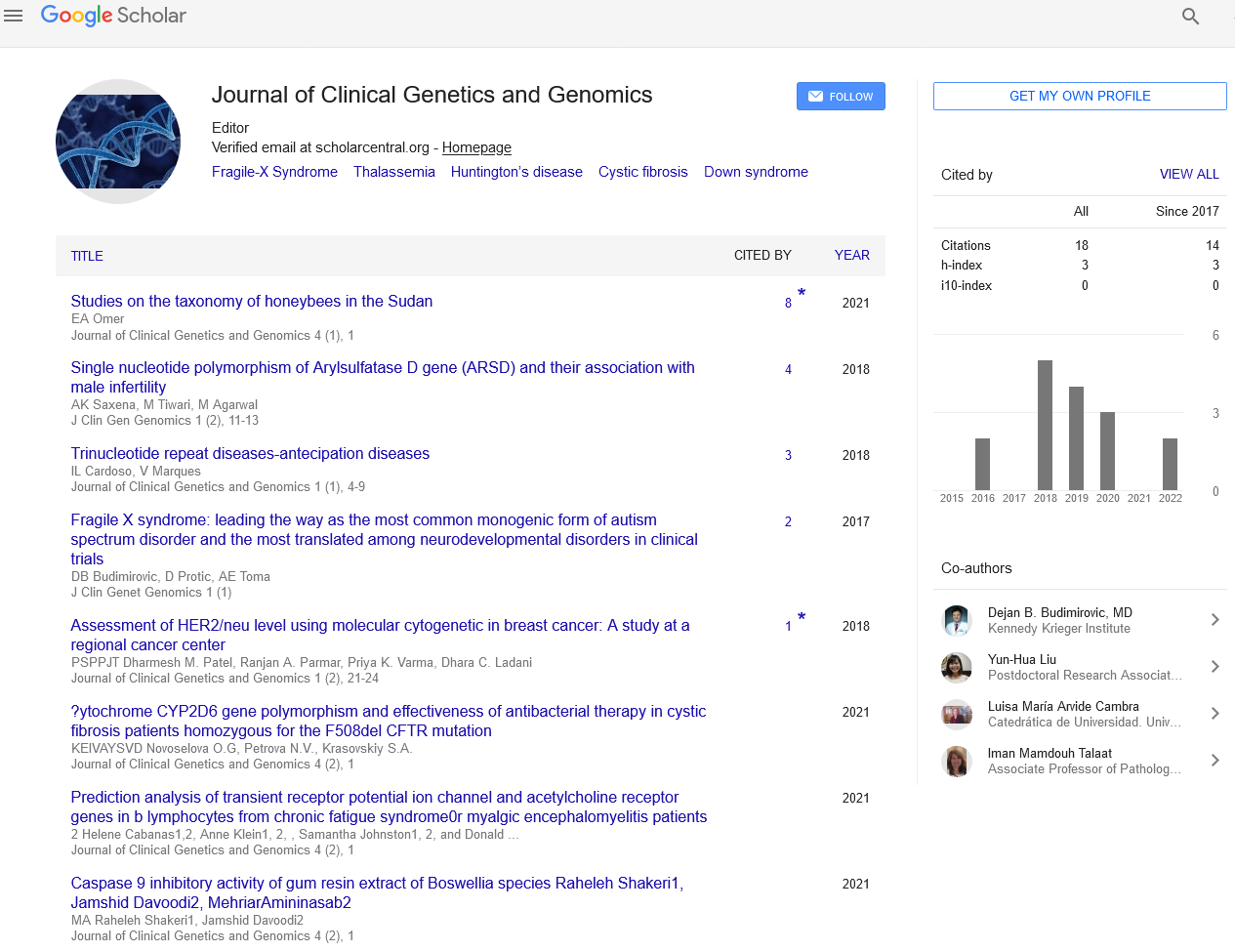The olfactory receptor gene family's gender bias in copy number variation is influenced by ethnicity.
Received: 02-Feb-2022, Manuscript No. PULJCGG-22-5482; Editor assigned: 04-Feb-2022, Pre QC No. PULJCGG-22-5482 (PQ); Accepted Date: Feb 15, 2022; Reviewed: 09-Feb-2022 QC No. PULJCGG-22-5482 (Q); Revised: 11-Feb-2022, Manuscript No. PULJCGG-22-5482 (R); Published: 16-Feb-2022, DOI: 10.37532/puljcgg.22.5(1).1-2.
Citation: Mason E. The olfactory receptor gene family's gender bias in copy number variation is influenced by ethnicity. J.Clin.Genet.Genom.2022;5(1):1-2.
This open-access article is distributed under the terms of the Creative Commons Attribution Non-Commercial License (CC BY-NC) (http://creativecommons.org/licenses/by-nc/4.0/), which permits reuse, distribution and reproduction of the article, provided that the original work is properly cited and the reuse is restricted to noncommercial purposes. For commercial reuse, contact reprints@pulsus.com
Abstract
The genetic makeup of people is significantly influenced by gender, which is also reflected in numerous genetic illnesses, most notably mental retardation. This study investigated its impact on copy number variation, which is known to cause genetic diseases. The olfactory receptor repertoire, which is made up of the biggest gene family in the human genome, was chosen for this study because it was conducted within and between 3 groups made up of 150 participants in the 1000 Genomes Project. The following novel findings were discovered through analysis of 3872 CNVs found among 791 OR loci, of which 307 loci indicated CNV: Both results suggest that gender has played a more recent evolutionary role. Sex bias in CNV was significantly more prevalent in one-copy number loss compared to complete deletion of OR pseudogenes and in uncommon than common CNV variants of OR pseudogenes, in which the male genome displayed more CNVs. Additionally, sex bias in copy number gain was found. Another surprising discovery was that ethnicity played a significant role in the observed sex prejudice, which was generally absent in East Asians. The use of these discoveries for enhancing clinical molecular diagnoses is highlighted using an example of sex bias in CNV among children with autism and a public CNV database for unwell children (International Standard Cytogenomic Array Consortium). Additional clinical relevance is discussed because the Prader-Willi syndrome/Angelman syndrome bi-directionally imprinted region, which is linked to two well-known mental retardation syndromes, is located close to the most polymorphic CNV-enriched OR cluster in the human genome, which is located on chr. The extensive retention of OR pseudogenes in females of this study may indicate a parent-of-origin indirect regulatory role for OR pseudogenes in the embryonic development of the human brain. Olfaction represents a primitive form of cognition in most mammals, possibly competing with the development of a larger brain. Therefore, any disruption in the olfactory system's temporal regulation could cause developmental delay issues, including mental retardation.
Introduction
It is generally recognised that many human genetic diseases, particularly those linked to intellectual impairments and developmental delays, exhibit sex bias. It is also known that males and females have distinct recombination rates. Additionally, parentof-origin deletion of imprinted areas is known to induce genetic disorders, and it has been demonstrated that many imprinted chromosomal regions are involved in sex-specific recombination. It is hypothesised that Copy Number Variation (CNV), the gain and/or loss of genomic materials, happens by non-allelic homologous recombination, demonstrating a direct relationship between CNV and recombination. Non-allelic homologous recombination occurs between interspersed duplicated sequences. Therefore, these diverse findings point to the plausibility of a connection between gender and CNV in both the general population and the study's participants with genetic diseases.
However, a big gene family with genome-wide representations rather than at the genomic level was the focus of this investigation. So, it was looked into whether or not sex played a role in CNV in the Olfactory Receptor (OR) gene family. OR genes are the largest gene family in the human genome, with over 900 members.They have also been extensively researched in relation to CNV.
Additionally, it is well known that the OR gene family contains a significant percentage of pseudogenes (about 50%). Many additional pseudogenes have recently been discovered in the human genome thanks to newly created bioinformatics methods, establishing them as regular components of the genomic architecture. Additionally, much more research over the past ten years has suggested that pseudogenes serve specialised regulatory functions. Since this big family of genes likely performs additional functions outside olfaction, such as acting as regulatory agents in early embryonic development, it could be a further sign that at least some of them are functional should the study's findings reveal sex bias among OR pseudogenes.
A total of 3872 CNVs with assigned copy number genotypes (ranging from zero to nine) were thoroughly analysed for this population genomics study, which was carried out at three levels: among all 150 individuals, as well as within and between three different populations made up of these 150 individuals. This population genomics study used publicly available CNV data for 791 OR loci obtained from 150 phenotypically normal individuals (57 males and 93 females) from the 1000 Genome Project. The main goal was to examine how gender affected the OR gene family's copy number variation (CNV), including whether it was more common in pseudogenes or genes, common or uncommon variants, and copy number loss or gain. The findings paint a surprisingly complex yet intriguing picture of how gender affects the CNV of the OR gene family. This intricacy gave rise to several theories about the indirect contribution of the olfactory system to the expansion of the human brain. Additionally, using a public database, sex bias was evaluated in the CNV of kids with intellectual disabilities and birth abnormalities in order to check the practical applicability of these findings.





